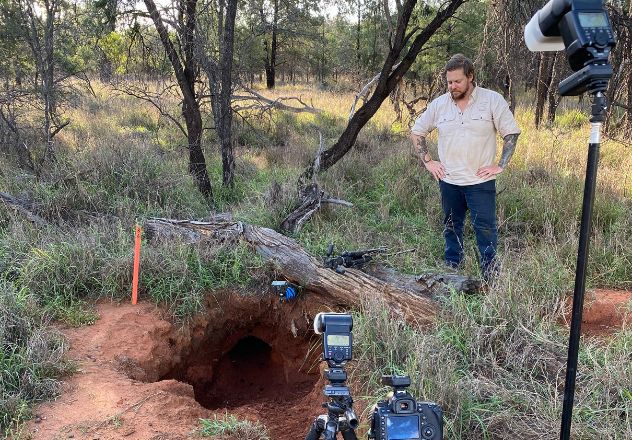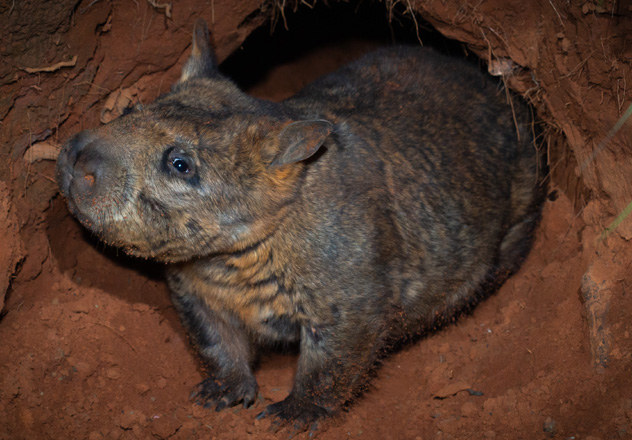The Northern Hairy-nosed Wombat is the largest burrowing marsupial in the world, and one of Australia’s rarest mammals. Once widespread throughout Victoria, New South Wales and Queensland, the species suffered a dramatic decline post-colonisation, leaving a single population by the 1980s at Epping Forest National Park. Their numbers continued to decline until just 35 individuals remained – at which point, Queensland Parks and Wildlife Service established a dedicated program to aid in the species’ recovery.
There are now two colonies of Northern Hairy-nosed Wombat in existence, with only an estimated 300 individuals remaining (far less than the Giant Panda or Black Rhinoceros) – a ‘stronghold’ at Epping Forest National Park and a second ‘insurance’ population at the Richard Underwood Nature Refuge (RUNR) in south-west Queensland.
In 2021, AWC entered a partnership with the Queensland Government to help conserve this species and establish new populations.

AWC Professional Photographer/Videographer Brad Leue spent some time at RUNR late last year, hoping to capture world-first photographs of these rare creatures. He shares his experience…
“I am often filled with gratitude working with Australian Wildlife Conservancy (AWC). It is inspiring to work with a group of motivated and caring people achieving real conservation success, and being given the gift of spending intimate time with the country and the unique wildlife that call it home. I have had a pretty good run in my career, having had the privilege to work in amazing places with some of Australia’s rarest species – the Northern Hairy-nosed Wombat being one at the top of my list.”
“There are just over 300 Northern Hairy-nosed Wombats left on the planet, far less than the Giant Panda or Black Rhinoceros. They are the world’s largest burrowing mammal maxing out at around 32kg and growing to over one metre in length. Just seeing their impressive burrow systems was a huge deal for me so being given the task to capture a portrait of the species was extremely exciting.”
 Andrew Howe/AWC
Andrew Howe/AWC
“The wombats at RUNR are known to be very elusive. Staff who have worked on the ground for decades have never laid eyes on one in the refuge. Wombats also have quite poor eyesight, relying heavily on scent to assess their surroundings – and as you can see in the photos, they have quite the tool for the job! This turned me away from the approach of waiting for a wombat to exit its burrow from a camouflaged hide. I had heard stories of wombats waiting Parks staff out in their burrows for 10-12 days, and although wildlife photography (and fatherhood) have taught me some things about patience, I felt the wombat would likely sniff me out in this case. Ultimately, using an un-maned camera trap would be the best option for success.”
 Brad Leue/AWC
Brad Leue/AWC
“The first step was to find a wombat… There are 12 wombats at RUNR and roughly 84 active burrows.”
“I was given a gift the day before arriving at RUNR, with heavy rain hitting the refuge. This presented somewhat of a clean slate to work with, revealing only fresh tracks taken by the wombats. Trail cameras were placed at burrows showing the most activity and assessed the following day to work out the best starting point. Most wombat burrows will have multiple exits, making the predictability of which one to focus on a gamble. On the odd occasion, you get lucky and find an active burrow with a single exit. Burrow six was it for me.”
“An aesthetically pleasing burrow, clear access, one exit and lots of tracks! Initially, I used trail cameras to get a sense of a) if there was a wombat using the burrow, and b) if there was a wombat still in the burrow. This also provided me with further information on the overall condition of the animal, times of activity, regularity of paths used, etc.
“For camera trapping, you need to manually set the focus point on where you predict the animal to be, so having as much information on movements and activity gives you a better chance of success. On night one, the trail camera showed a very healthy, active animal heading out for the night, exploring for the bulk of the night and then returning home to rest. We had a wombat!”
“From here, everything surprisingly fell into place – which is extremely rare with camera trapping. My camera was framed and positioned the following day, moving meticulously through the environment to reduce any noise and trace of my smell. An infrared sensor was positioned on a log above the wombat’s burrow to be triggered precisely when the animal’s face/eye would enter the focus point set on the camera. Diffusers were placed on flash units to soften and spread light evenly and the camera was configured to fire three photos on a detection. Using a 100mm macro lens allowed me to capture the animal with sharp detail, whilst keeping the camera setup at a safe distance.”
“The first night provided a series of photos that were far greater than I had hoped to produce, showing a stunning individual exiting its burrow for the night. The following night, I used a similar setup to capture 4K video of the same individual coming and going, which is known to be the first-ever footage of the species in high definition. Reviewing the cameras in the morning was a special moment for the soul, and a special moment shared between myself and Andy – the ecologist on the ground. I was happy with what I had captured and packed my gear up after two nights of success to avoid any further interference with the animal – walking away with some great pictures and lasting memories. It is almost impossible to make eye contact with an animal as rare as the Northern Hairy-nosed Wombat – though I think capturing this image allows us to get pretty close.”
Support Australian Wildlife Conservancy's science-led conservation work and safeguard the future of Australia's native species
Donate Now